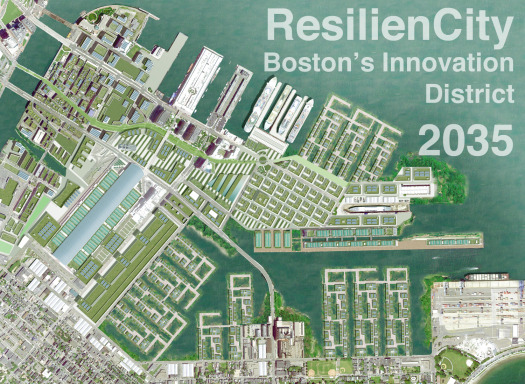
ResilienCity: Boston’s Innovation District 2035
The International Living Future Institute launched the Living City Design Competition in 2010, seeking designs for our cities in the year 2035. map-lab’s submission was ResilienCity. ResilienCity seeks to set the vision for the future of Boston’s Innovation District, a new neighborhood built on greyfield and brownfield sites that will provide residences and workplaces for over 300,000 people. We have reached the tipping point where we need to think of the whole, not the self. We have arrived at a time when we need to stop behaving selfishly and begin to explore how we can all come together as a community to create environments that are culturally enriching, healthier, and equitable. We come back to nature to do this.
Site:

Our design proposal for Boston’s Innovation District incorporates a strategy of new canals that gives 100 acres of land back to the sea and provides for roof gardens and living walls throughout the district with the goal of re-establishing long lost ecological conditions. In total our proposal provides over 15 million square feet of green spaces for recreation and green roofs. In addition, we transform a major downtown Boston street into a pedestrian friendly boulevard modeled after the Ramblas in Barcelona.
Water:
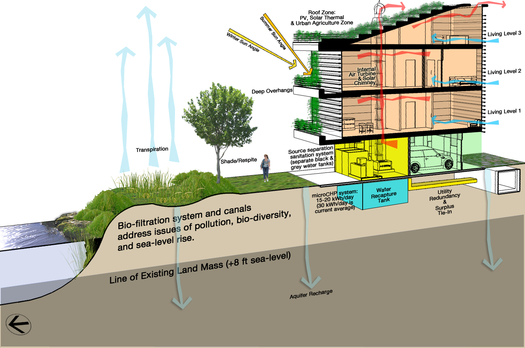
Our net zero strategy includes transforming an existing bus tunnel into a 20 million gallon district water cistern. Our “coastline” restoration at the Canal Districts residential developments remove existing hardened edges (granite seawalls) to provide permeable surfacing that allow for aquifer recharge through reconstructed wetlands.
Energy:

Our energy strategy provides 4 times what is required in our district. Our project is able to do this using a variety of processes including photovoltaic systems on building roofs and the roads, biogas using organic waste, and MicroCHP strategies at individual building scales.
Health:
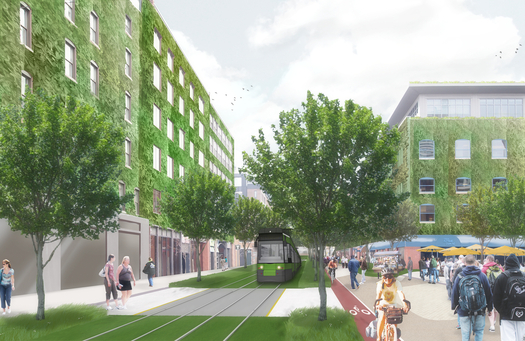
We have designed ResilienCity to encourage all visitors, workers, and occupants to be active and educated about their health. Vehicular traffic has been substantially reduced in the ResilienCity by increasing public transportation and by relocating the tractor-trailer trucks to a new Eco Industrial Zone.
Materials:

An important part of our strategy is reuse of existing buildings and a self-imposed limitation of 500 km radius for sourced materials. All buildings in ResilienCity will contain a building nutrition label that provides nutritional value to occupants. This label will provide information about energy, water, waste, and will also warn occupants of red list materials. In addition, the label will provide occupants with the current embodied energy “debt” related to the building construction.
Equity:
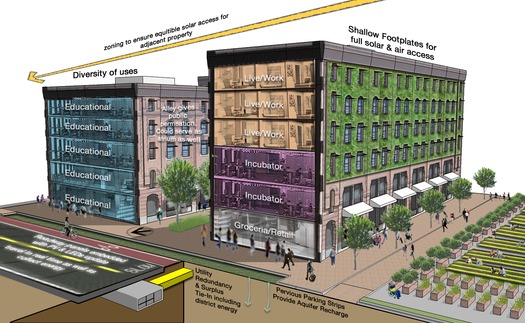
We have stitched ResilienCity together with the previously divided South Boston community and provided them with new waterfront and a new trolley system. From a planning perspective the community will feature programs that help build community including day care facilities, an elementary school, a food market, a medical center, and community center buildings for residential areas.
Beauty:
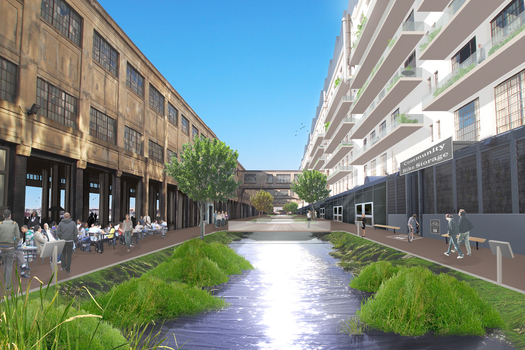
Our project provides for educational opportunities about nature, self (health), buildings, and community. Along with the physical signage (nutrition labels on buildings and functional diagrams of the ecosystem at work) comes the embrace of the ever expanding “on-demand” information and the devices evolving to meet that demand for information. By taking the precedent of the carbon card deployed (in research) by London, we expand on that to create a model for the engagement and tracking activities. This “carbon card” (though really it’s a resource card) is an embedded synthesis of the economic (debit card) and the ecological (embodied energy factors) “costs” of things. This device, an evolution of smart phone technologies, becomes your “wallet”. Accessed by the user only, through bio-activation, are your ID card, your communications/data accessing device, your credit/debit card, embodied energy measurer, as well as health status (i.e. blood sugar levels, cholesterol, etc.)



